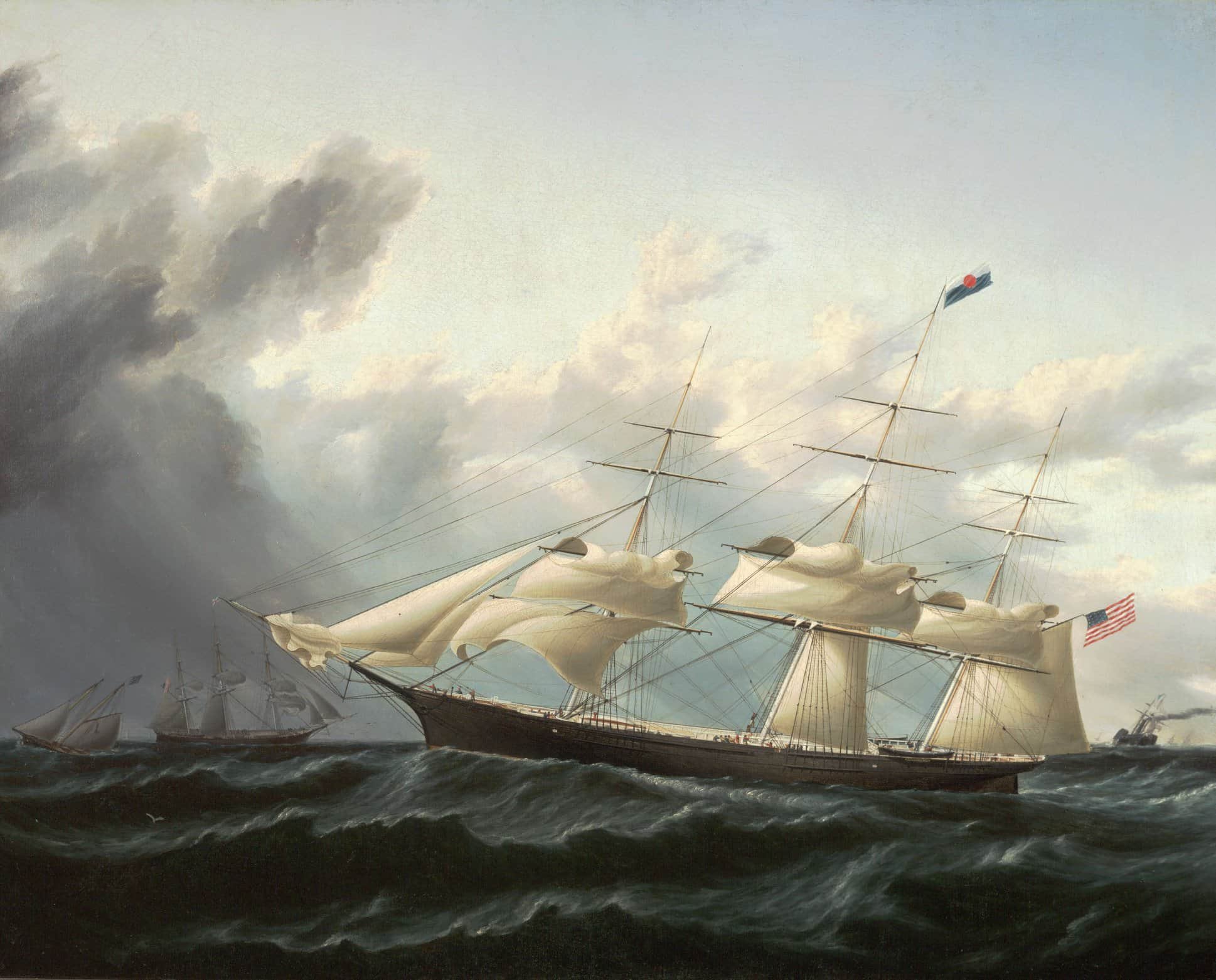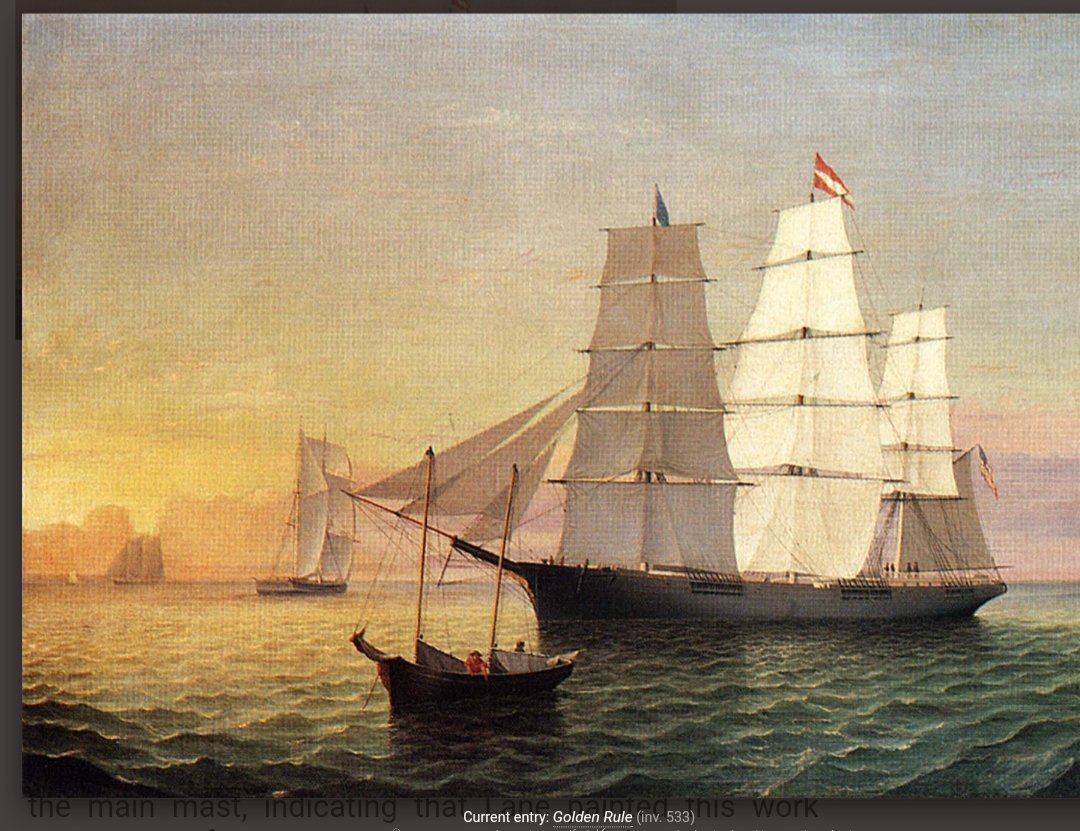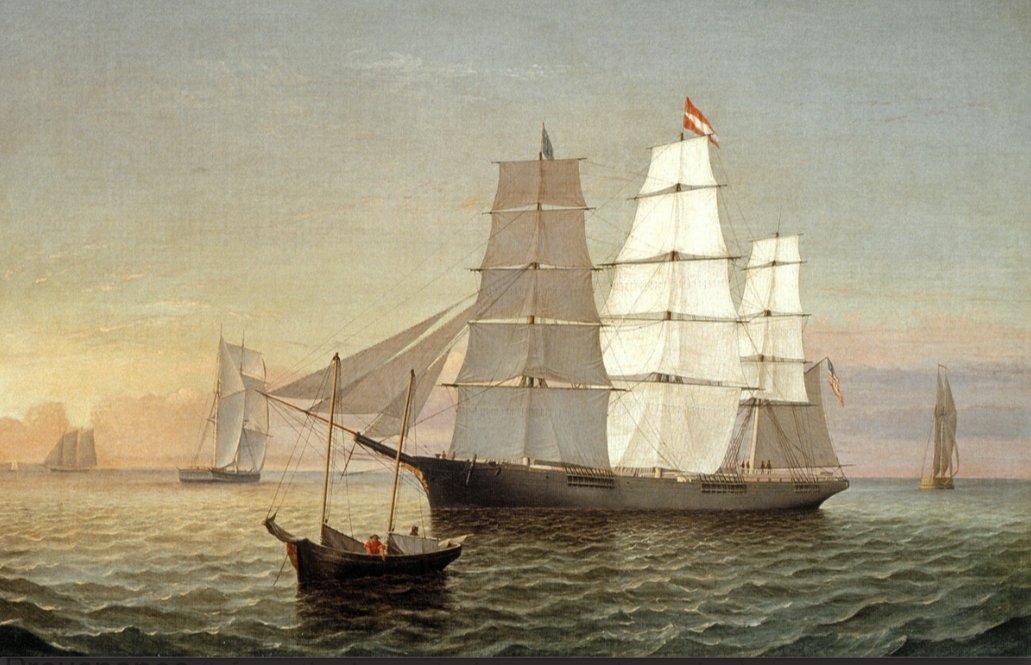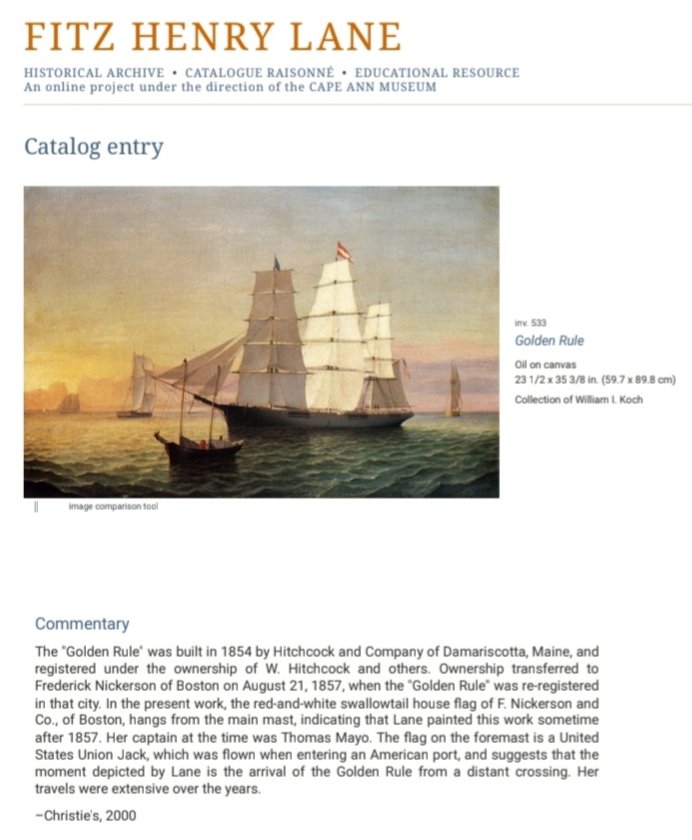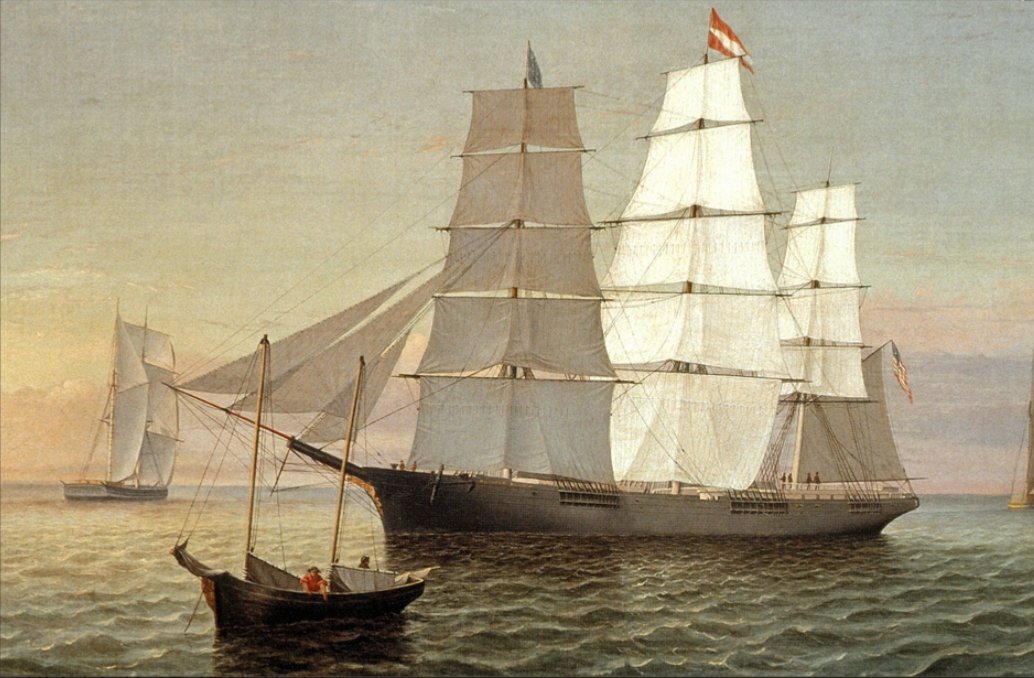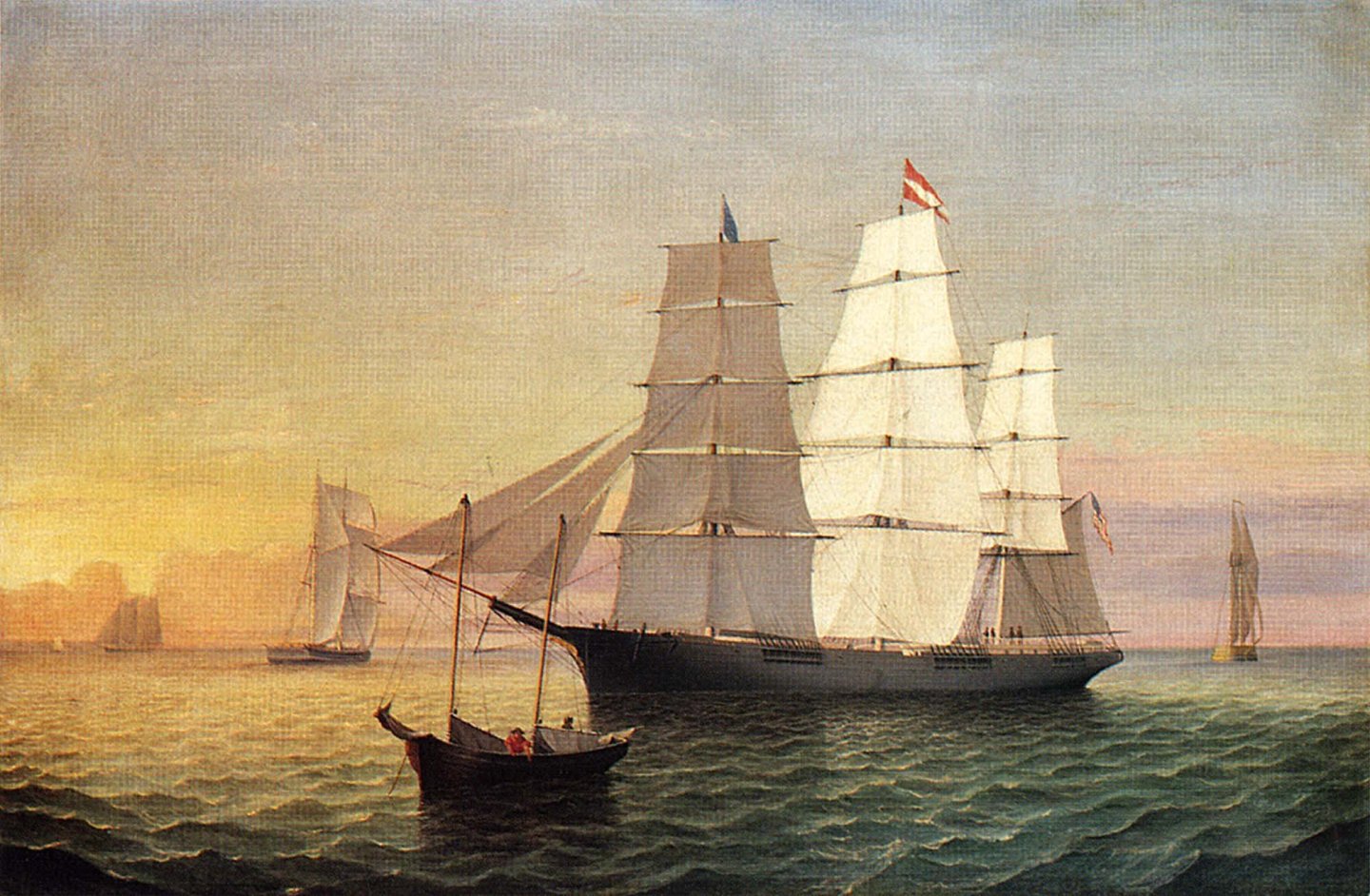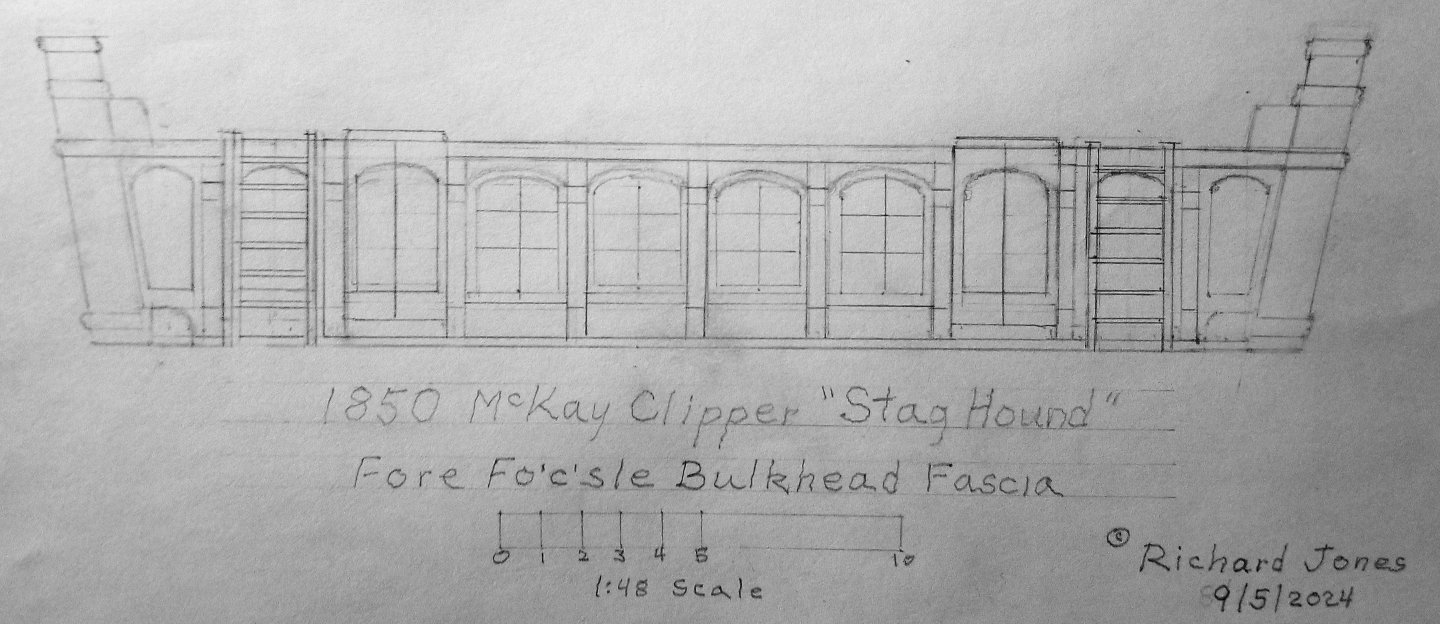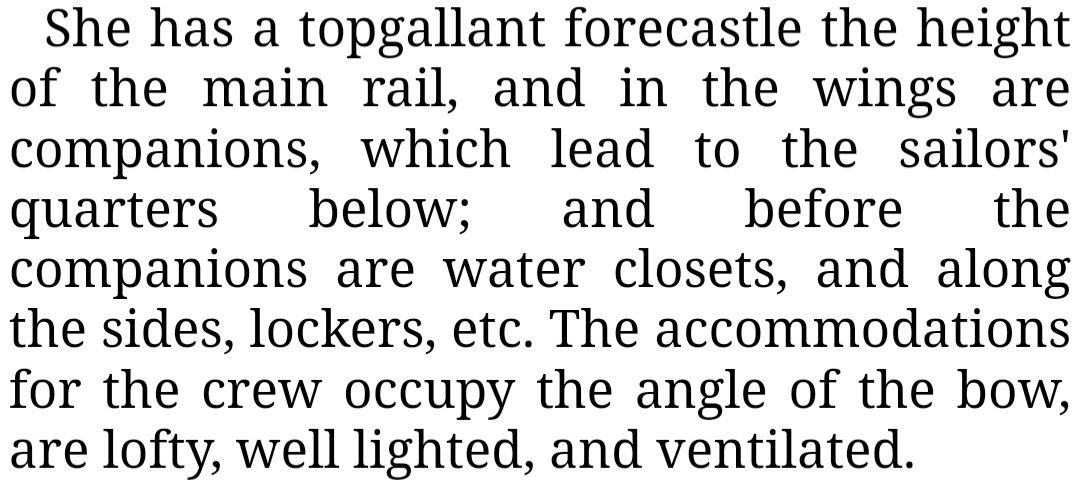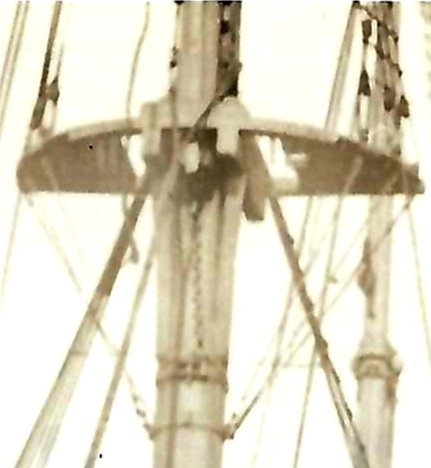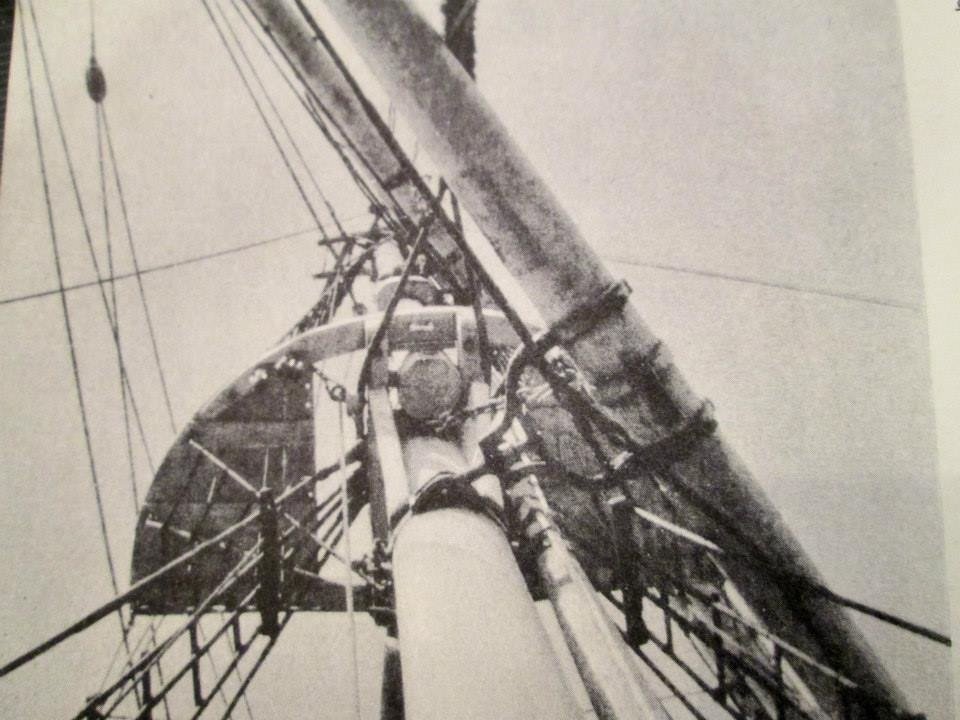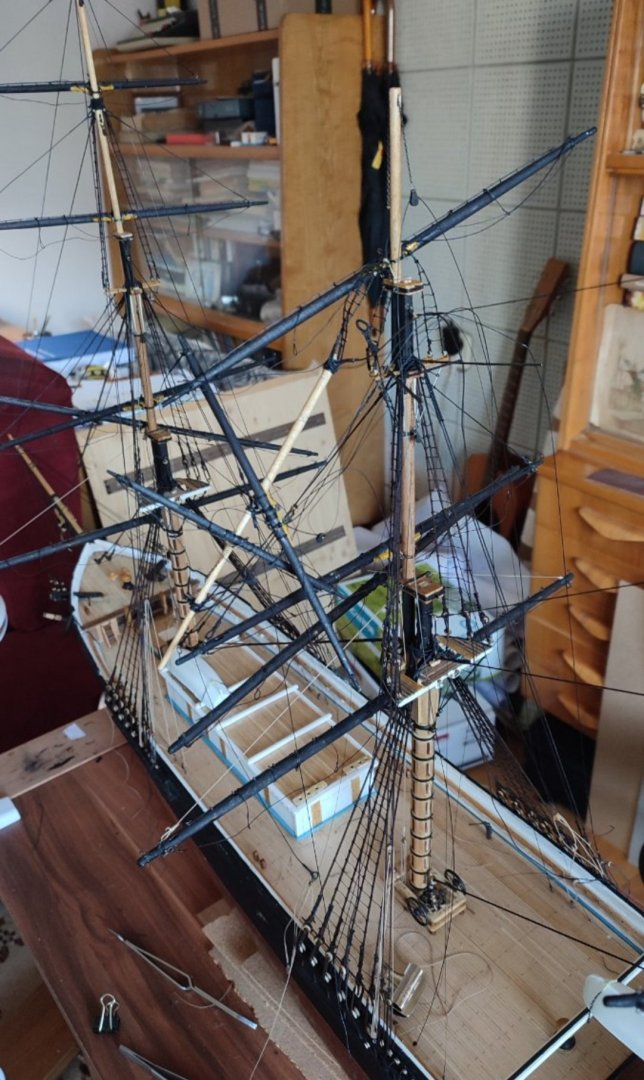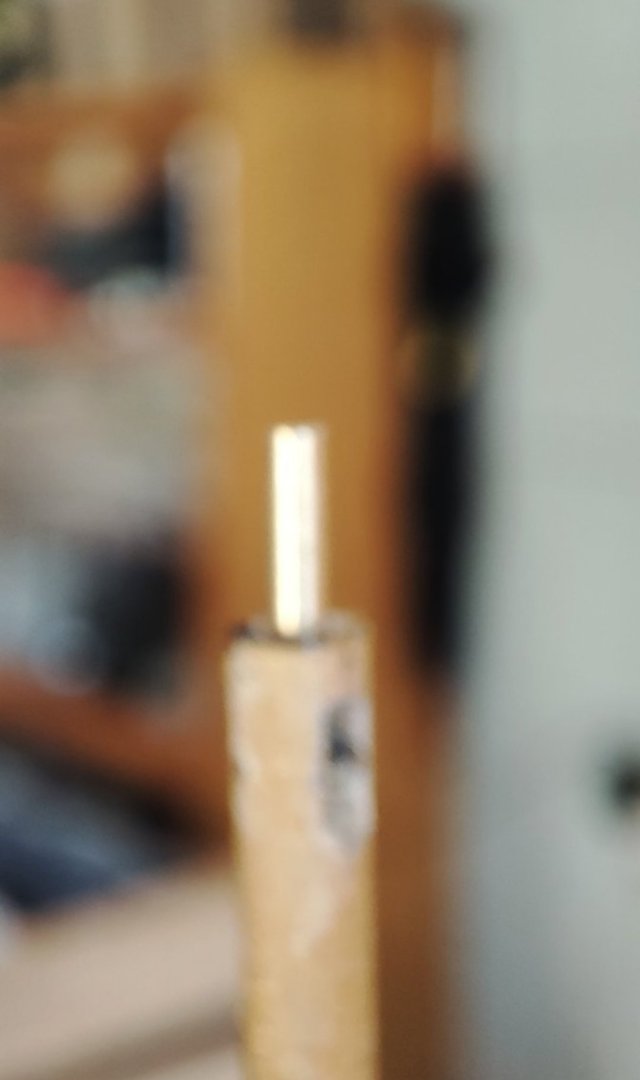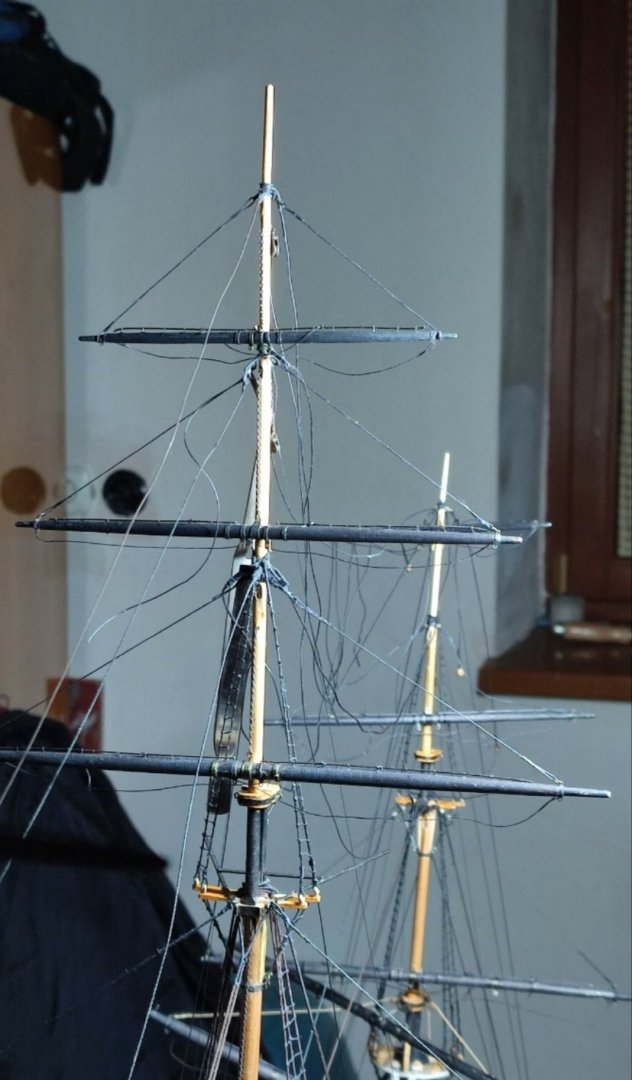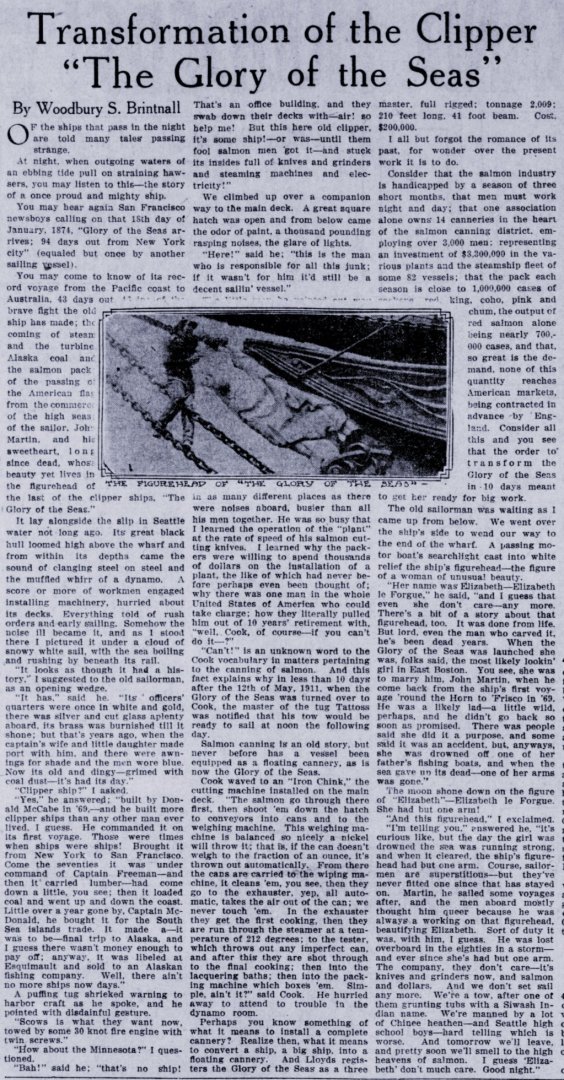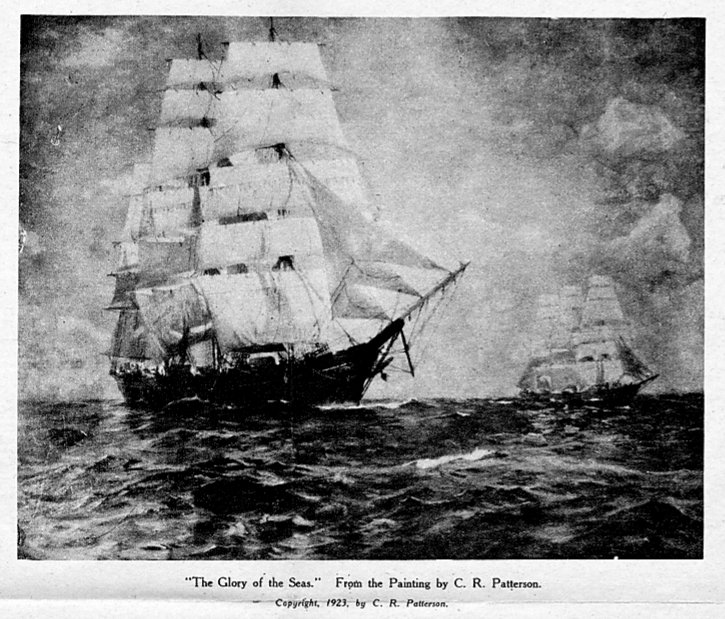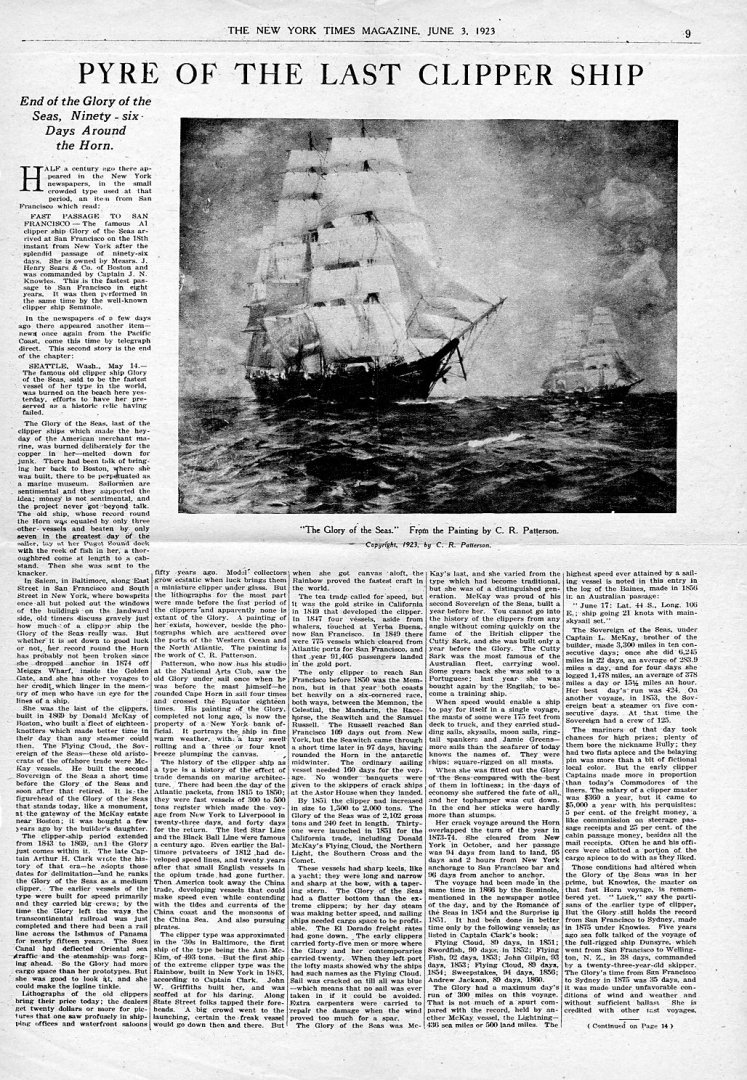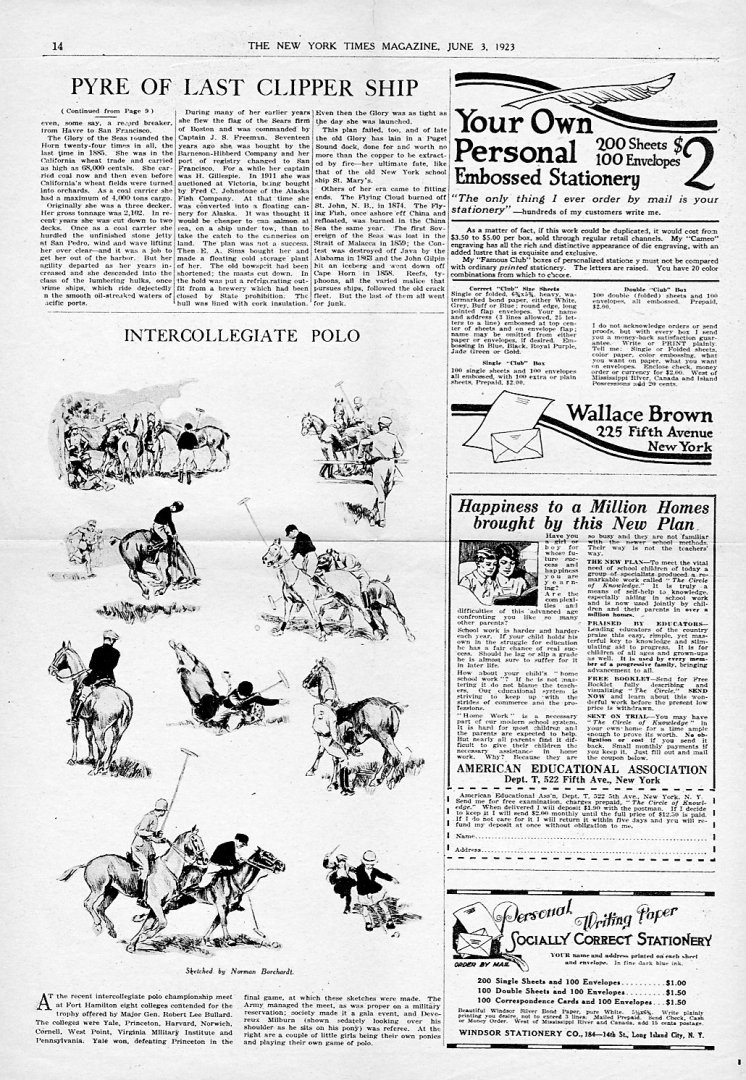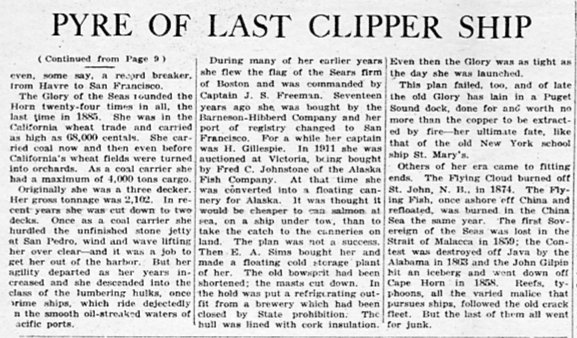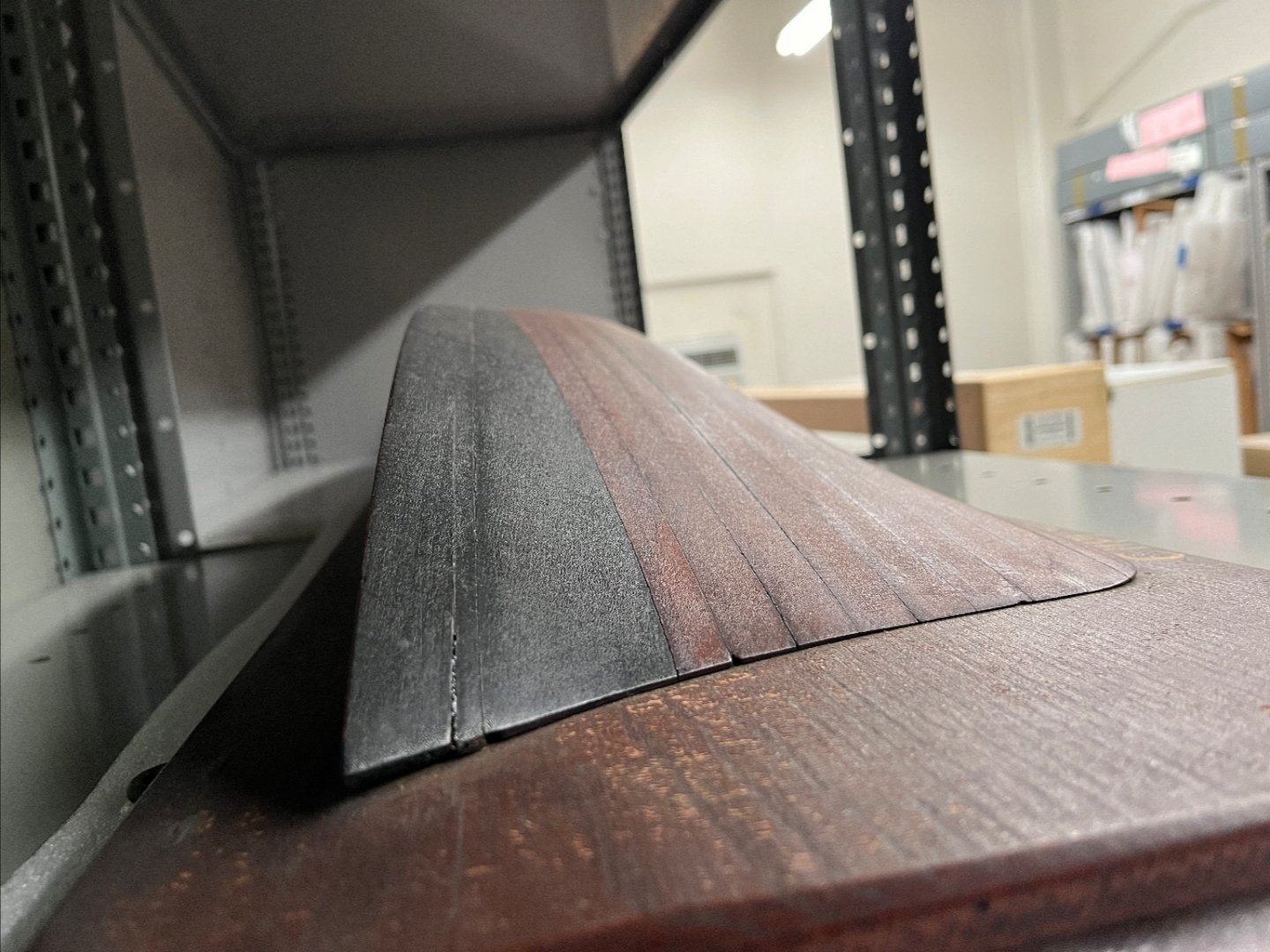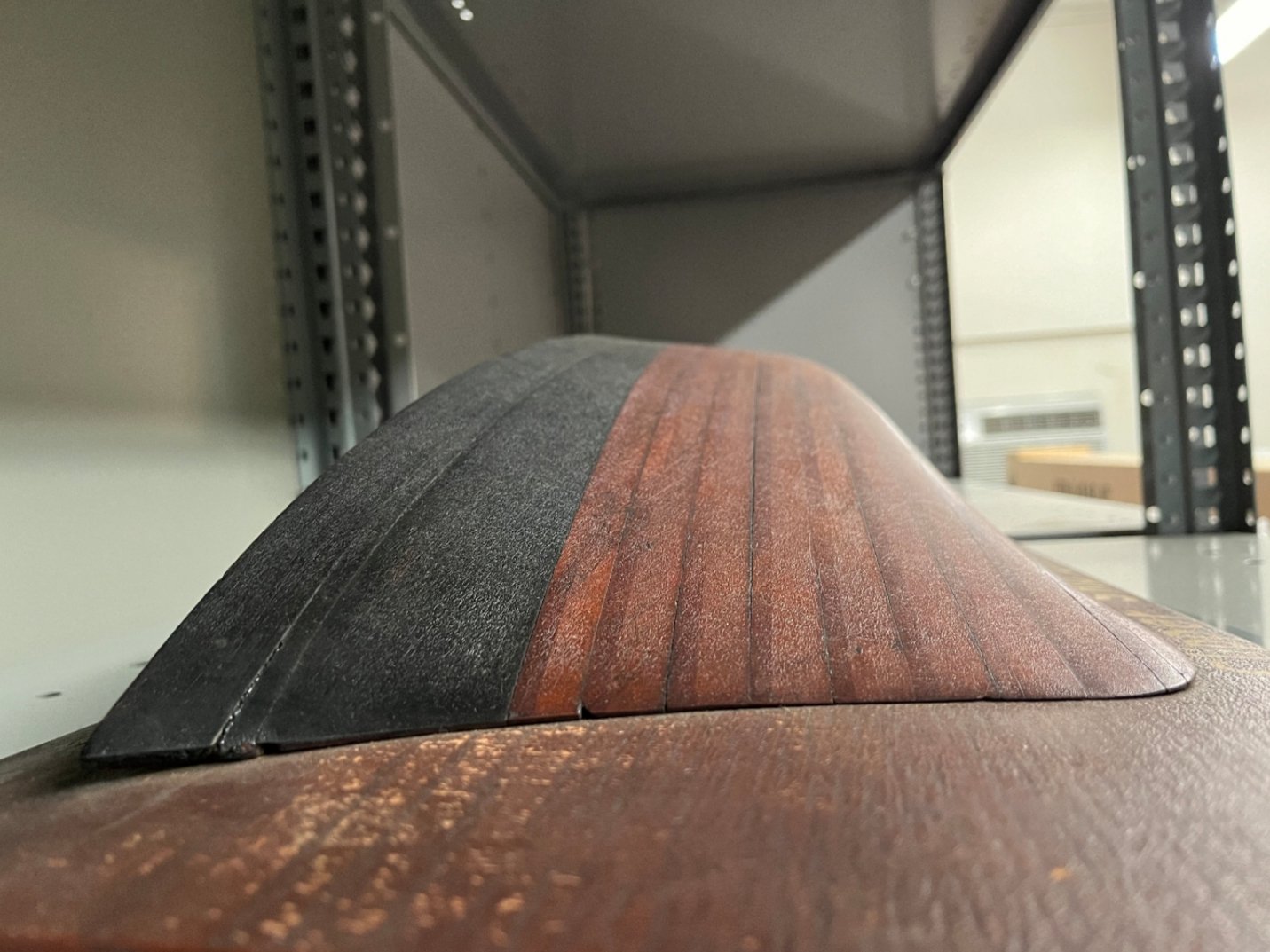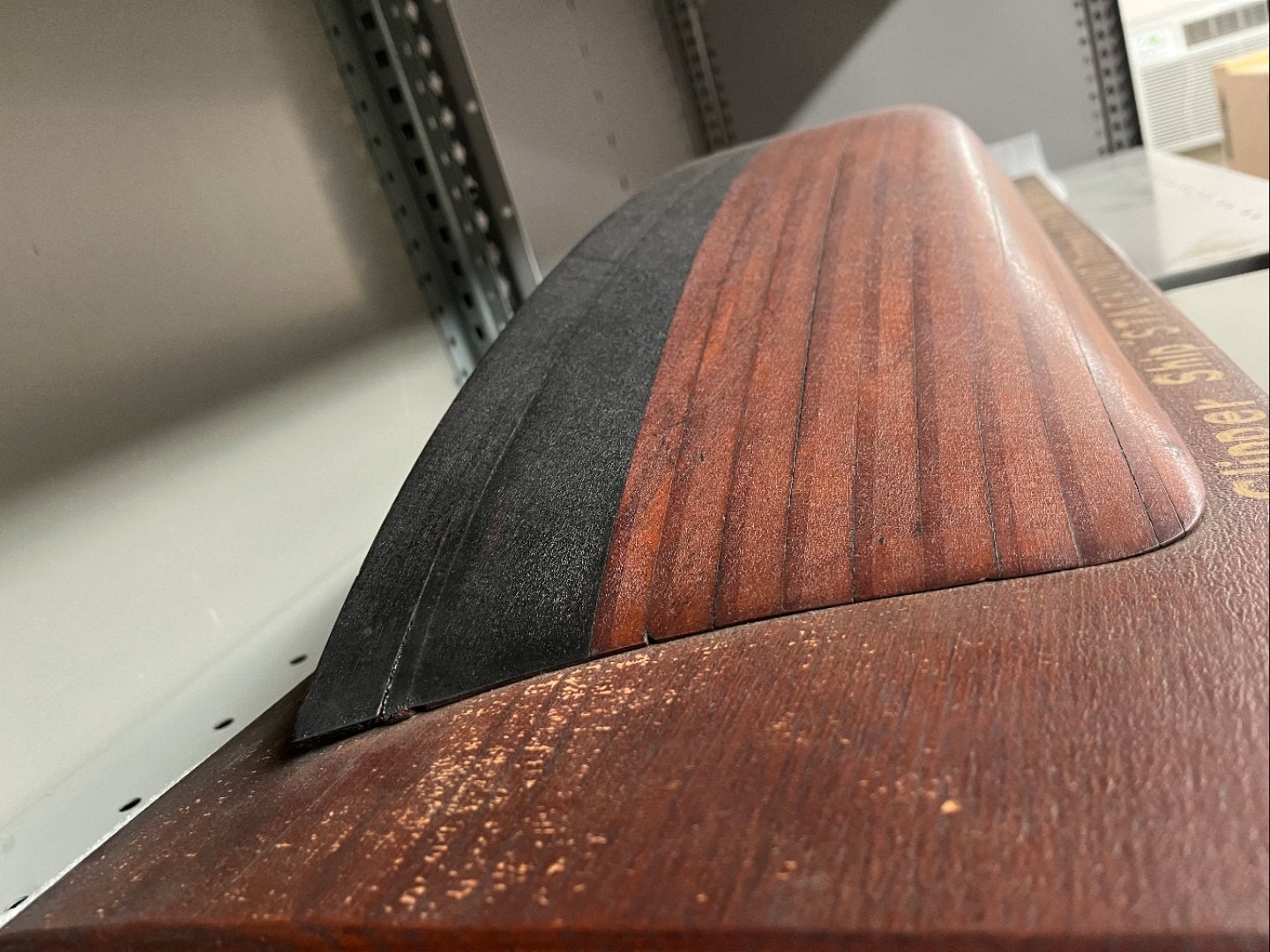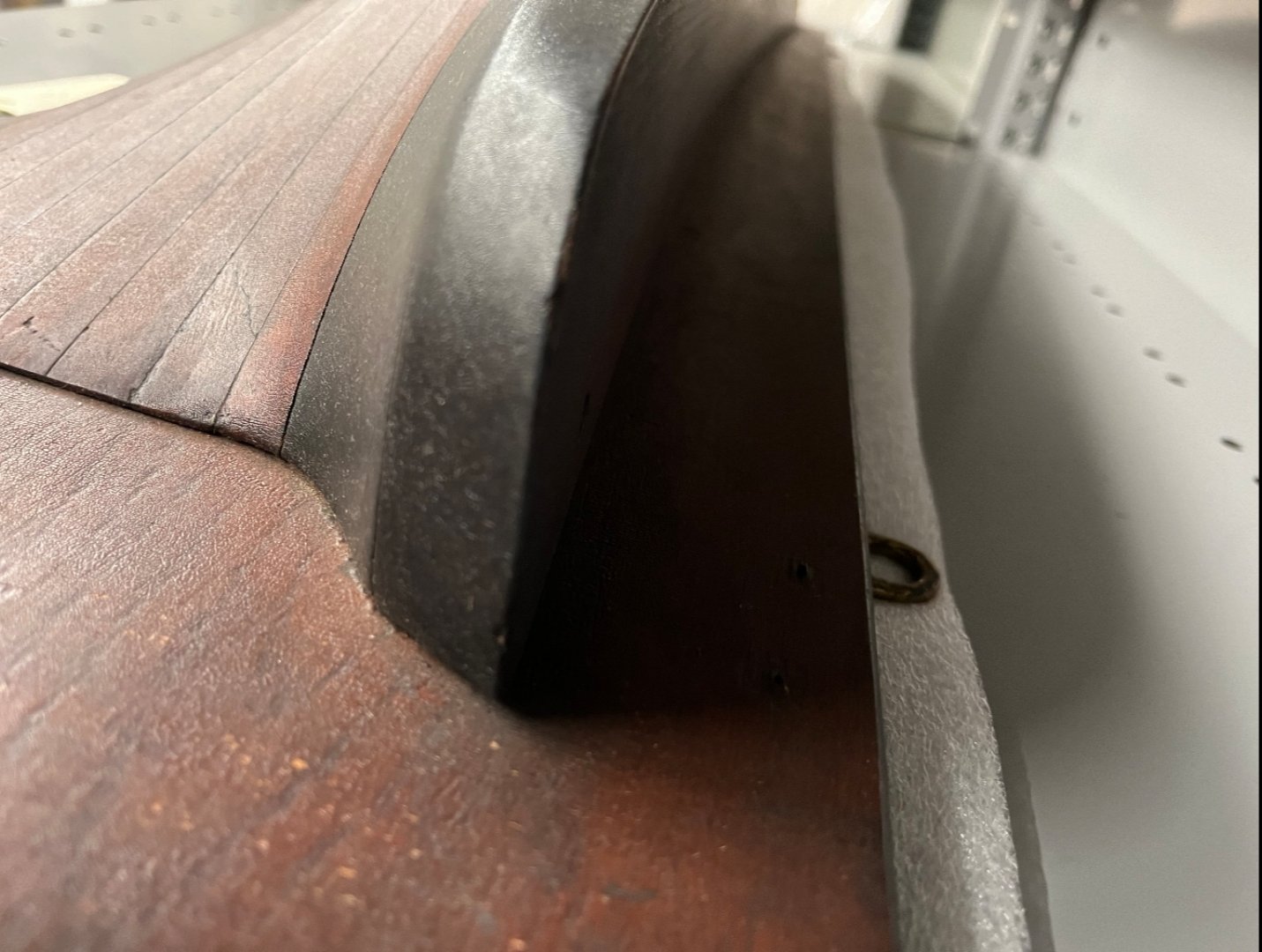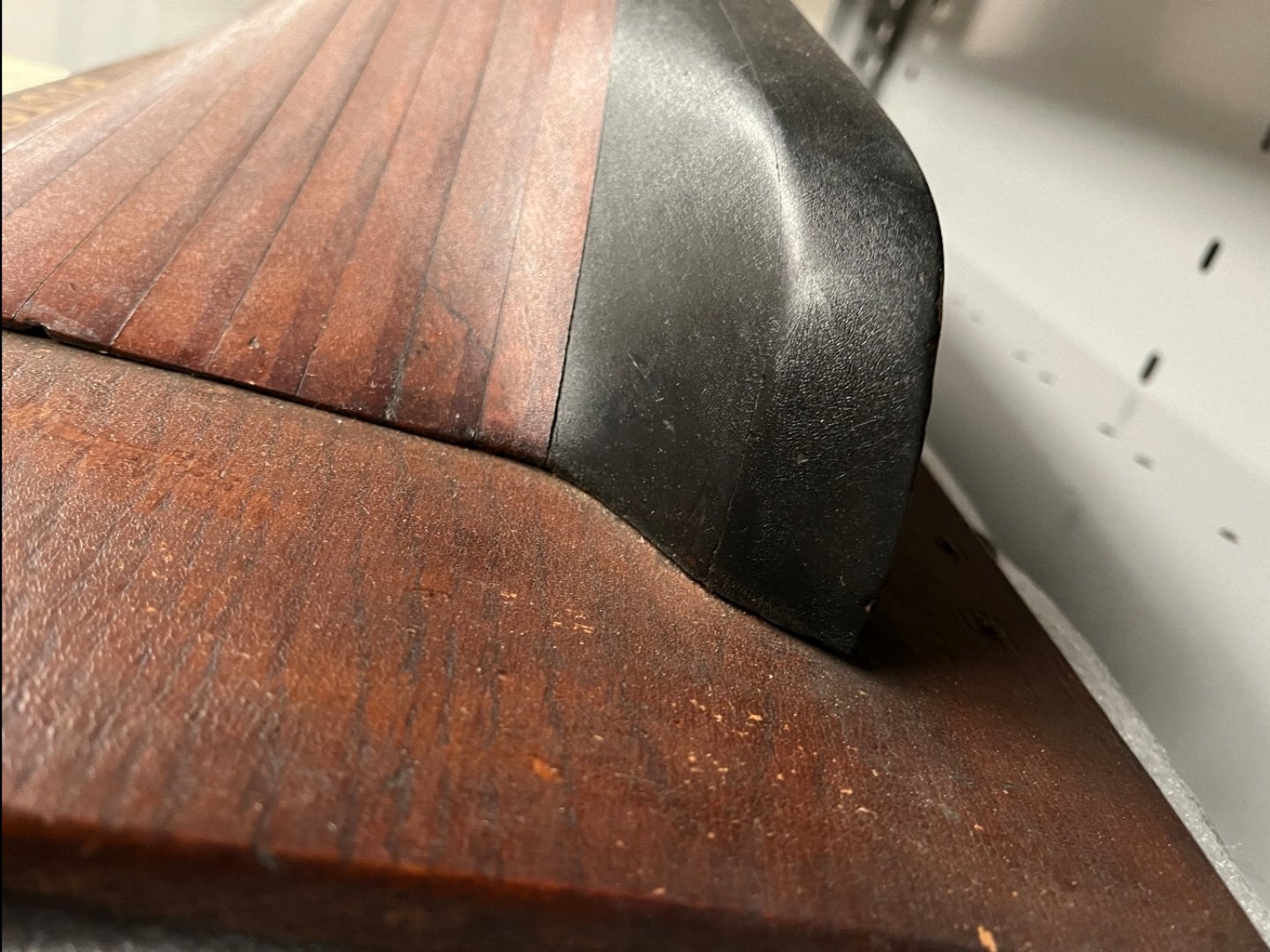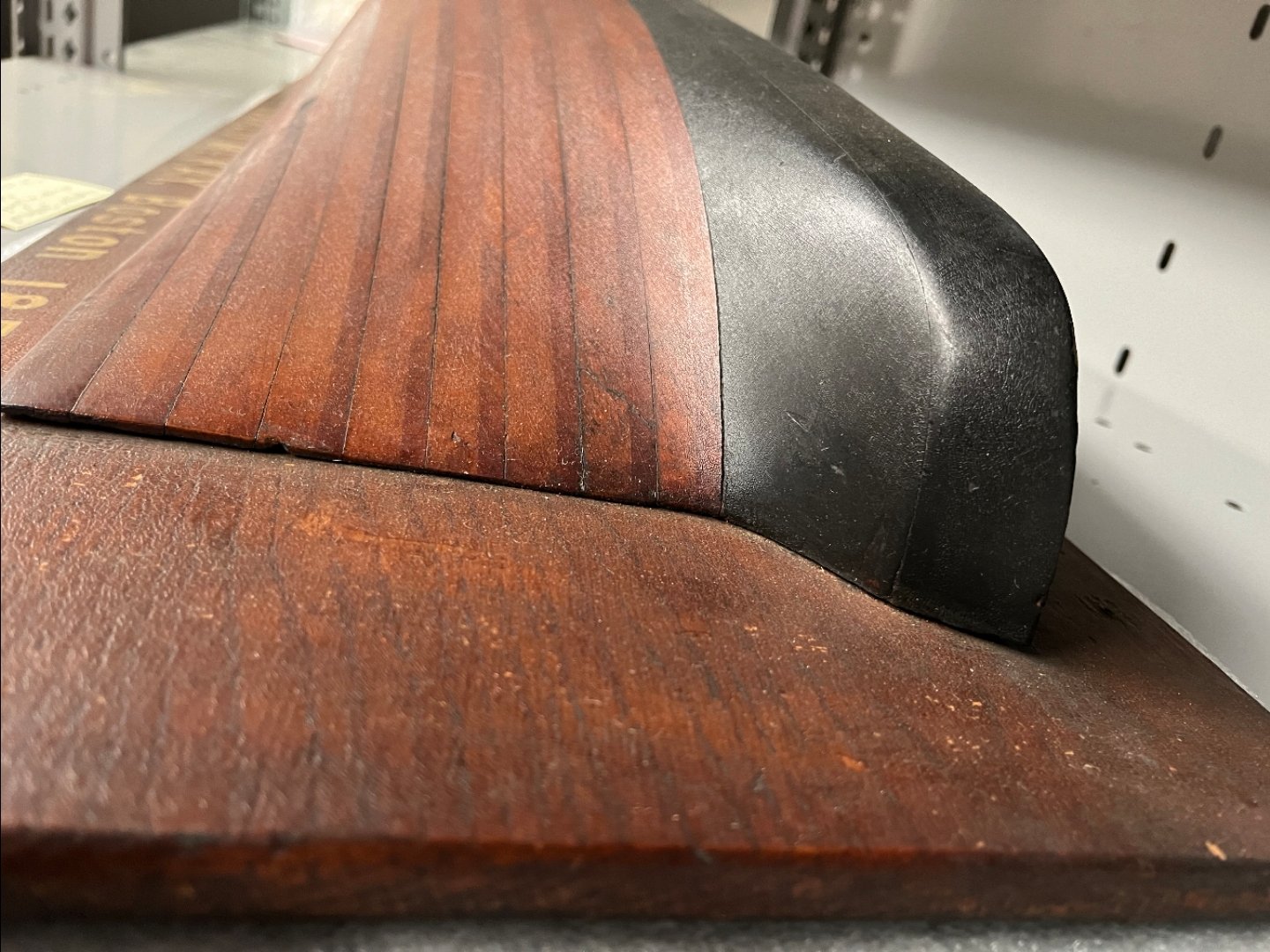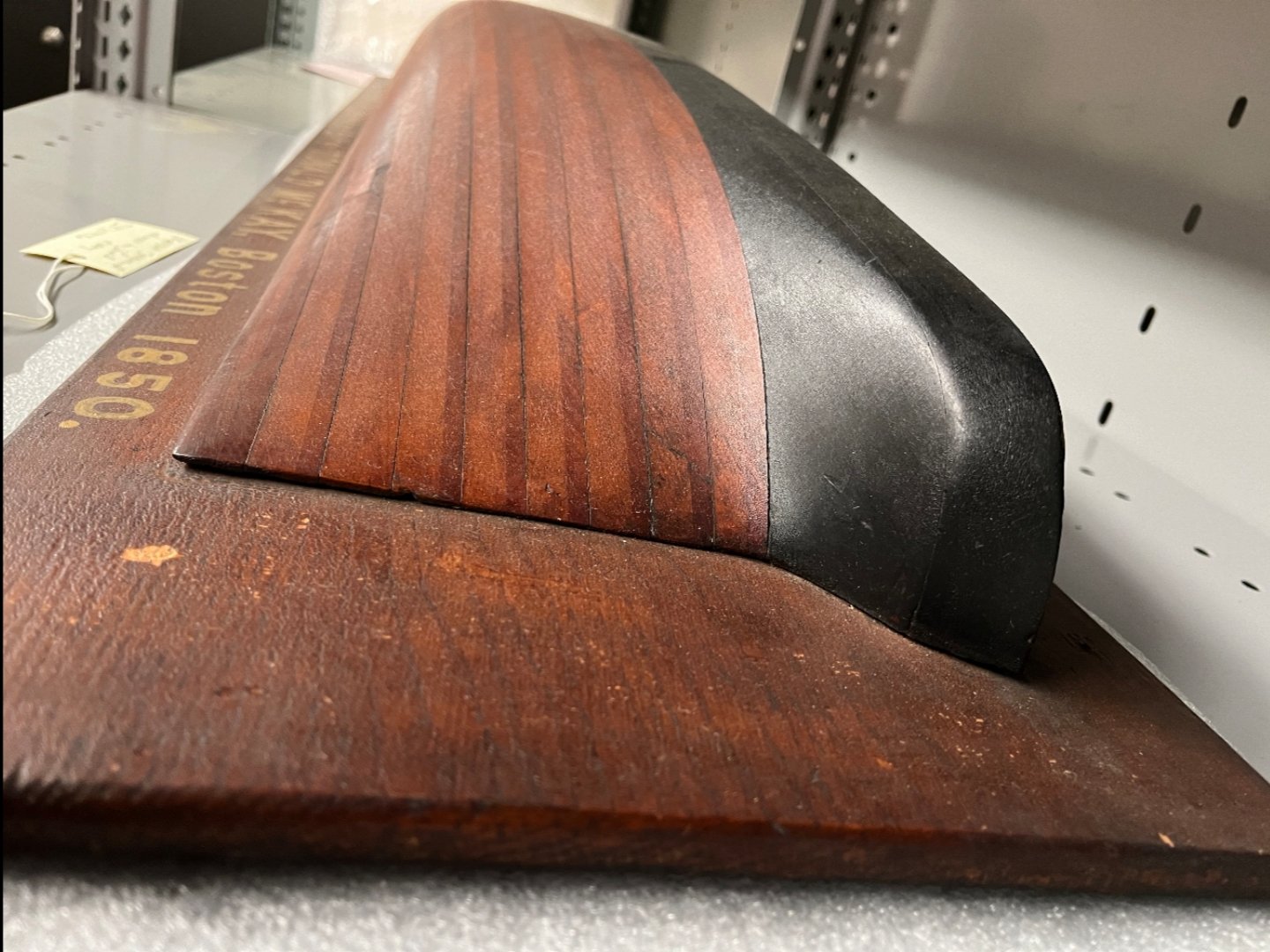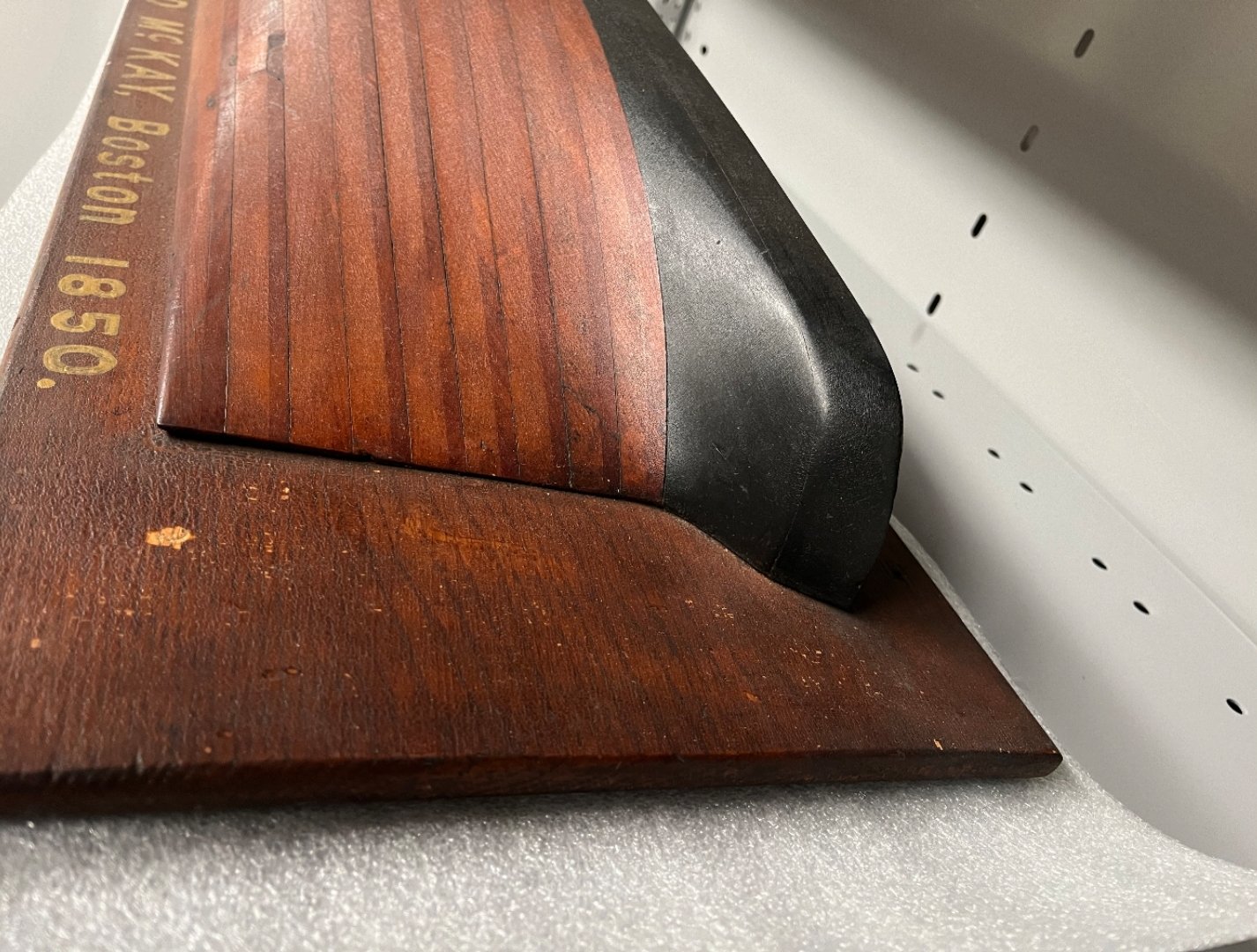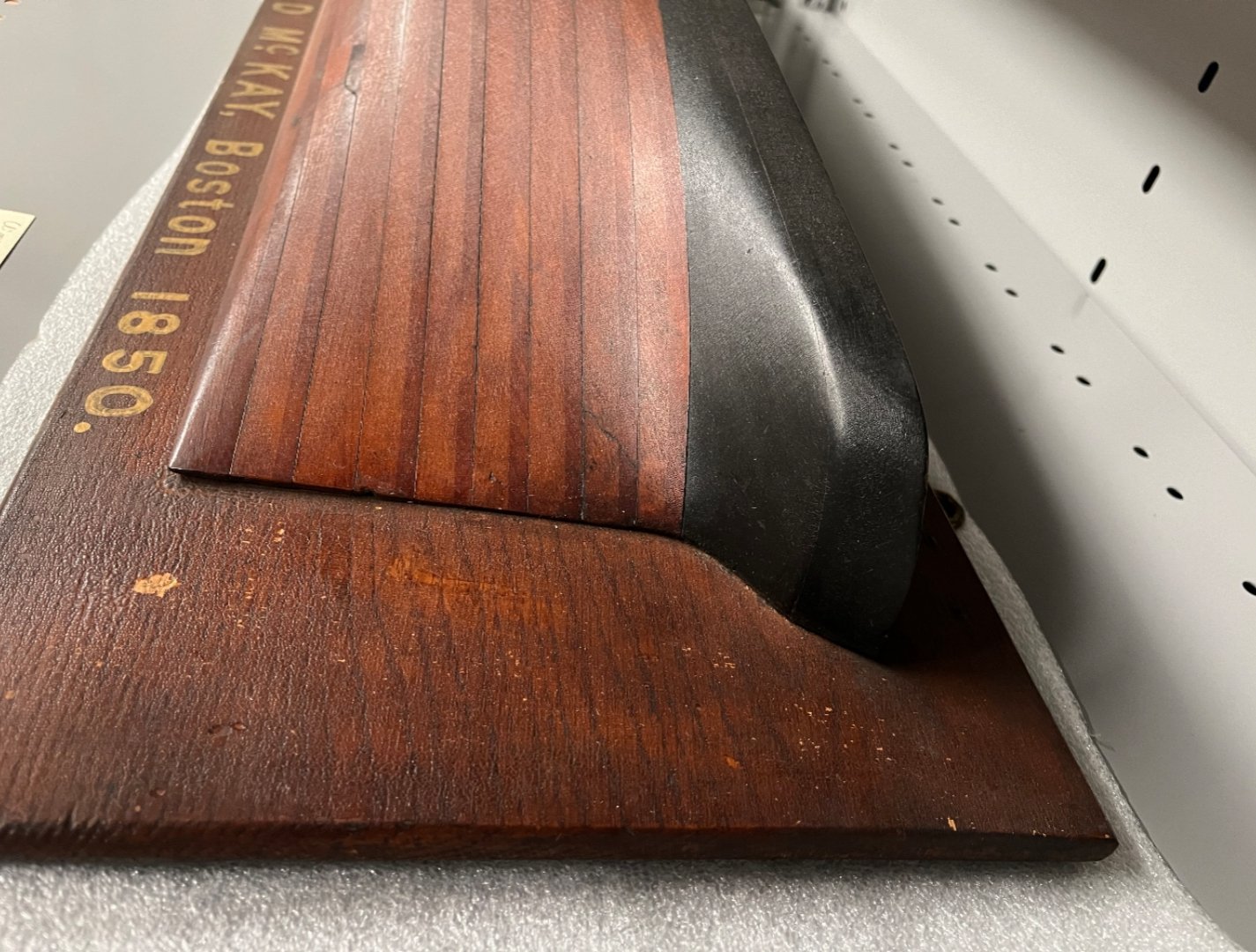-
Posts
2,168 -
Joined
-
Last visited
Content Type
Profiles
Forums
Gallery
Events
Everything posted by ClipperFan
-
@Rick310 First, thanks for sharing the entire Ogily piece. I agree in the case of Golden Rule she appears to have twin water closets just abaft her forecastle. You can also see her plain cutwater with what appears to be a golden dragon overlay for her figurehead. Note: lack of navel hoods, head or trailboards. Interestingly enough, I found the beautiful Fitz Henry Lane artwork you described but not the one you shared. Go Figure. I also searched for a detailed description of her to see how high her bulkheads were but so far have had no luck. To my knowledge, of all McKay California Fleet Clippers I've read about, Flying Fish had the lowest main rail height of 4 & 1/2' surmounted by a monkey rail of 16" for a total bulkhead height of 5'10". Meanwhile her 'tween deck height was 7'10". Concerns I have about the Lankford arrangement have to do with reconciling his layout with the Duncan McLean description. It's evident from the highly detailed specifications that McLean was supplied those from the McKay shipyard. That makes the Lankford layout virtually impossible. His forecastle is wide open with a windlass jammed inside what's effectively a crawl space. It makes no sense. Crew quarters are definitely described as being below. That being the case, why leave their lodgings unenclosed? Meanwhile, McLean clearly stated that she had two waterclosets before her dual companions. To leave them on the upper deck means somehow companions have to be aft of them. Do we double stack them one after the other? That wastes valuable space. A more logical setup is to enclose the forward forecastle bulkhead, place twin companions in the wings of this aft wall with ladders to 3' below. Place twin "heads" before or just ahead of those companion ladders down below. Since this is now an area that's at least 7' high, mount the windlass below where there's planty of room to work on it. Logically it all fits.
- 345 replies
-
- Flying Fish
- Model Shipways
-
(and 1 more)
Tagged with:
-
@Rick310 Emerson-Walker patented their iron geared windlass in 1850. From memory it was June or July of that year. Rob and I concluded that such heavy machinery would have been mounted further below both for better weight distribution and protection against elements. Once that decision's made, the rest falls in place. There are definitely accomodations for a watch of the crew. Since the windlass requires extra height, that necessitates dropping the floor. That then means the fore forecastle bulkhead must be enclosed. A lower deck also opens up room to provide crew's quarters as well. Since water closets are in the wings of the forecastle, it makes sense to have them lower and available for crew. In choosing to have a single companion opposite a single water closet, Ben Lankford chose to ignore the specific description provided by Duncan McLean for Flying Fish. I shared his short paragraph above. He wrote that there were twin companions with water closets before (not aft or opposite) of them. Both of the companions lead to crew quarters below. Before the companions are the water closets and lockers, etc. The entire description applies to the area below. Since the forecastle doubles as forward crew quarters, then the aft bulkhead would have to be enclosed. According to the description, her forecastle deck was 4 & 1/2' high. Where do you fit a windlass unless it's either completely outside or down below? Logically, it makes more sense to mount it below. As for Ben Lankford's design, maybe he didn't have access to the Boston Daily Atlas article. I just know his layout doesn't match the description. The first solid top picture I shared was of the Glory of the Seas. Since iron was used liberally in her construction, it's most likely her top brackets were reinforced iron. All I know for sure is that she had full length lubber's holes on all 3 solid tops. I'd love to see the entire Golden Rule piece, it looks quite impressive. I tried to find a full description of her but so far I haven't found anything other than that she's a Maine clipper launched in 1854.
- 345 replies
-
- Flying Fish
- Model Shipways
-
(and 1 more)
Tagged with:
-
@Jared those dowel masts look very durable. An added benefit will be that they also won't even flex when you rig them. That should result in a more accurate overall look to your replica. Great decision to select tougher wood to model those thinner spars.
- 431 replies
-
- Flying Fish
- Model Shipways
-
(and 2 more)
Tagged with:
-
Rob I intentionally copied the layout for those deck structures seen on Glory of the Seas. That includes doors on the aft portico of Stag Hound as well as her aft central companion. All windows are higher up for the same reason.
- 345 replies
-
- Flying Fish
- Model Shipways
-
(and 1 more)
Tagged with:
-
@Rick310 As you may already know, @rwiederrich @Vladimir_Wairoa @Luis Alvarez and I are working on realizing an accurate model of McKays Stag Hound the "Pioneer craft of the California Clipper Fleet". Our evaluation of the Duncan McLean description of the patented windlass with gears led us to find the Emerson-Walker heavier geared windlass. Rob and I concluded such a weightier device would have been mounted further below. This area below the forecastle also provided accommodations for one watch of the crew. It was described as well lit, lofty and ventilated. We concluded that those accomodations were 3 feet below, identical to the arrangement of the Flying Fish you're currently building. Here's my illustration of the forward bulkhead. This differs dramatically from the commercially produced plans. There are windows to provide light and twin companions to ladders below. Before each companion, in the wings of the forecastle below are located twin water closets. In fact, stern water closets on Stag Hound were also located 3' below the 5' high poop deck. This differs substantially from your Flying Fish plans which show twin water closets aft of a single centrally mounted companion not before as the Boston Daily Atlas clearly describes of her. In fact, we relied on this description of the topgallant forecastle in our reconstruction of Stag Hound. Another reason this arrangement makes more sense is considering working height of the Flying Cloud, Flying Fish and Stag Hound forecastle decks. Flying Fish had a main rail height of 4 & 1/2' while the Stag Hound and Flying Cloud both had a topgallant forecastle height of 5'. Underneath the height would have been 3 & 1/2" less! That brings Flying Fish forecastle height below to 4' 2 & 1/2" and Stag Hound, Flying Cloud forecastle heights below to 4' 8 & 1/2". When you consider Donald McKay's 'tween decks all had 7' or taller heights, having such "crawl space" heights to work on a windlass and provide any sensible rest area for crew doesn't make sense. Dropping the floor 3' below solves this problem. That then means the aft forecastle bulkhead doubles as a stern wall for windlass and crew accommodations. In fact, we now believe whenever topgallant forecastle height is at the lower main rail, this would be the same set up for all of McKay's clippers. To be clear, I am not suggesting you tear down any of your current work. I'm just sharing our latest discoveries for any others who plan on constructing similar McKay clippers.
- 345 replies
-
- Flying Fish
- Model Shipways
-
(and 1 more)
Tagged with:
-
@Rick310 Congratulations on your retirement. I hope you had a great cruise vacation celebration. I love seeing your progress on your beautiful Flying Fish replica. In case it hasn't been pointed out before. Here's an issue of authenticity that your build plans have wrong. Both @rwiederrich and @Vladimir_Wairoa had to redo their solid tops because of this common mistake. Their Lubber's Hole entrances were way too small in comparison to the real thing on 1869 Glory of the Seas as pictured in the first page and 1843 Whaler Charles W Morgan in the second. The Lubber's hole is longer than commercial plans, which have a ridiculously small one. In reality, the opening goes clear from the fore curve bracket to the aft straight one. When you think about it, this makes more sense. Imagine trying to squeeze many crew through the tiny one provided for in your plans. It just isn't practical. Meanwhile real ones are far more useful for multiple crew to utilize. In addition you'll find it far easier to rig your shrouds as well.
- 345 replies
-
- Flying Fish
- Model Shipways
-
(and 1 more)
Tagged with:
-
@rwiederrich I did say it was long. Still, when Mike read it the only changes he recommended were a few reference corrections. I have a very solid 3rd installment devoted exclusively to Vladimir's build and I'm determined to submit that before the Jan 1st 2025 deadline. Next there's our Stag Hound project which I want to get a jump on. Next year is the 175th Anniversary of her December 7th 1850 launch. Donald McKay's incredible contribution to Boston's amazing fleet of California Clippers deserves to be recognized.
-
@Vladimir_Wairoa Thank God you're recovered from the damn Covid. That is great news!! For the record, I only sent my 3rd draft to you, in hopes of collaborating about your timeline for building, tearing down and rebuilding efforts. The delay in getting the 2nd article submitted earlier was in large part my journey of discovery of your amazing build. Once I realized how complex alone your construction process was, it became clear there has to be a 3rd article devoted exclusively to your replica. The 2nd article is a very long one but it just felt right to cover Rob's fascinating rigging process in depth. By the way Vlad, even though I have no immediate plans to build one, I still want to acquire a set of the Stag Hound bulkheads just like I did for Glory of the Seas. I don't want to miss out on having a set for Stag Hound. Just let me know the costs and I can pay you via Paypal or even mail you a check. @rwiederrich with the tight timeline of a handful of days I didn't have enough time to go through and select more of your finished images.
-
Rob, Check your emails. I sent both Microsoft Word document Google links to you. It's a long but I truly hope fascinating read. Without exaggeration, it's probably the most detailed recount of your systematic, highly organized rigging process ever written. There's tons of gorgeous photos accompanying it.
-
@rwiederrich, My 2nd Reconstructing Glory of the Seas article for the Nautical Research Journal draft was submitted on-time to meet their Winter 2025 issue. No guarantee it will appear in that one yet. By now you should have received both my final and then finished drafts. It was too late for @druxey to give it an editorial review. However, I learned how to use the internal Microsoft Word editor which gave me a 96%. Mike was nice enough to review my final draft and I made a handful of source corrections. One fascinating correction was the date of the San Francisco wharf scene is actually 1880 not 1877. Other than an honorable mention, @Vladimir_Wairoa had to be left out for a third promised installment. I have until December 31st this year to submit it and I fully intend to meet it. Vladimir's build is a fascinating journey of construction, tear-down and reconstruction. In the end he, as a relative novice to rigging a clipper ship, managed to create the most beautiful 1869 Glory of the Seas replica. Meanwhile, I included in the second article that Mike has declared your 1877 miniature to be the most accurate Glory of the Seas replica ever produced.
-
Basswood has a janka hardness of 410, degame is 1,940, yellow birch is 1,260 and inexpensive while boxelder is 720 which probably explains why your thinner masts keep snapping. https://www.precisebits.com/reference/relative_hardness_table.htm
- 431 replies
-
- Flying Fish
- Model Shipways
-
(and 2 more)
Tagged with:
-
@Jared It's got to be unnerving to be constantly concerned about snapping delicate spars. I wonder if there's a way that you could devise a temporary protective splint or jig device to minimize a chance of this happening? I think such an approach would be less potentially messy than a pre-application of super glue. Meanwhile, Rob has an excellent in-process description of his methodical systematic rigging approach in his most recent Glory of the Seas build log. He does multiple sub-assemblies, even on his yards before they're mounted to each mast. He uses alligator clamps to suspend each yard as he pre-rigs them. He does a similar thing with his mast, only putting them in a vise while assembling each one. Rob also leaves off the largest yard, the main or course sail until last. His build and rigging process starts with the mizzen and goes forward from there. He's also said, to prevent damage, he waits to install the jibboom until later too.
- 431 replies
-
- Flying Fish
- Model Shipways
-
(and 2 more)
Tagged with:
-
@Jared Wow! I feel your frustration with that bit of bad luck about your broken mast. It looks like you have done a decent repair job. Our friend @Vladimir_Wairoa had a similar rigging disaster when his lines suddenly snapped off his main royal mast. In his case, since he was working on the larger 1:72nd scale, he inserted an internal copper splint. His clever repair job is practically invisible. Since your vessel is smaller 1:96th scale, obviously Vladimir's option would have to be done much smaller. Like maybe a cut-off pin or tack. I've included scenes of Vladimir's repair so you can see what I'm describing. For future reference, of course.
- 431 replies
-
- Flying Fish
- Model Shipways
-
(and 2 more)
Tagged with:
-
@rwiederrich @Vladimir_Wairoa I figured out how to use another flash photo feature on my cell phone. Here are 2 articles I found years ago but couldn't share until now. First is "Transformation of the clipper the Glory of the Seas." This newspaper article describes Elizabeth Le Forgue as being the live model for the Grecian goddess Athena figurehead. There's a tragic story told by an old seaman who apparently sailed on the McKay clipper in her earlier years. It has to do with the figurehead's loss of an arm. Spooky tale. Rings true to me but who knows? The second article is from The New York Times Magazine, June 3, 1923. Another sad topic about the fiery demise of Glory of the Seas. However, it also includes some of her very fast passages, including one record which remains unbroken today. These journeys belie her assignment as a medium clipper. Fascinating read. FYI: My second long delayed submission to Nautical Research Journal was done September 30th and met the October 1st deadline. Since Vladimir's tale was far more fascinating and complex than first anticipated, I'm doing a 3rd installment exclusive to his first ever rigging job. Next year is the 175th Anniversary of the launch of Stag Hound "The Pioneer craft of the California Clipper Fleet" as so eloquently described by Cornelius McKay. Success of Stag Hound led to 18 years of some of the most phenomenal California and Australian clipper ships to ever sail the seas. I'm developing another article to cover our build process on her too.
- 3,560 replies
-
- clipper
- hull model
-
(and 2 more)
Tagged with:
-
@Jared Your friend's dad made a beautiful large Revell model Constitution. It's a shame about those sails. Depending on how important it is to her to save the sails, I would use a thin toothpick, apply the thinneest line of krazy glue on one edge and hold the two pieces together until it sets, usually a minute or two. Once all repairs are done, I would then paint a light coat of white on both sides to protect and strengthen them.
- 431 replies
-
- Flying Fish
- Model Shipways
-
(and 2 more)
Tagged with:
-
Rick310, There's just something so mystical to me about this particular piece. Perhaps it's because Donald's son Cornelius McKay crafted her directly off the mold lines lifted from the lofting floor as Stag Hound herself was being built. Next year is the 175th anniversary year of Donald McKay's entry into the rapidly heating up competition to bring material and passengers to the West Coast. It's the anniversary of the launch of Stag Hound "the Pioneer craft of the California Clipper Fleet". That's how Cornelius described her in his letter to Capt Arthur H Clark when he turned over his beautiful model and line drawing on November 18th, 1896.
-
@rwiederrich @Vladimir_Wairoa @Luis Felipe Lori Fidler, Associate Director of Collections, Old State House Museum, Boston, MA just sent me nine more photos of Cornelius McKay's glorious clipper Stag Hound model. She took some nice bow and stern pics but due to shelf location, couldn't get any of the rest of the model. Immediately noticeable is her sharp 40 inches at half-hull floor. This is what makes some refer to her as McKay's sole extreme clipper. His second California Fleet Clipper Flying Cloud while still an extreme clipper had a 10 degree flatter floor with 30 inches at half-hull. Gradually McKay continued with flatter floors, culminating in his final medium clipper Glory of the Seas which had a mere 8 inches at half-hull but was nonetheless still a very sharp clipper design.
-
@rwiederrich can you specify the exact types of lines or threads you used for running vs standing rigging. From the pics and descriptions @Jared is describing, it looks to me like he might be using oversized lines.
- 431 replies
-
- Flying Fish
- Model Shipways
-
(and 2 more)
Tagged with:
-
@Jared Your port side lift is tighter. I haven't rigged models in years but from viewing @rwiederrich rigging, it appears like he uses thinner lines. Maybe he can describe the scale of lines he utilizes. I will see if I can find any references he made on his Glory of the Seas build.
- 431 replies
-
- Flying Fish
- Model Shipways
-
(and 2 more)
Tagged with:
-
@Jared Rigging is probably the most patience trying aspect of a beautiful clipper ship. I like how you used small weights to get a more natural look to your footropes. I also respect the many challenges of rigging in tight confines. However, it looks like you can still get your lines a little more taut by taking slack out at top of yard ends. Now that your fife rail is secured, it should be no problem to tighten lines at the top. Nice work on siezing your lines too.
- 431 replies
-
- Flying Fish
- Model Shipways
-
(and 2 more)
Tagged with:
-
Rob, Good catch on the black boats. It strikes me as odd that craft possibly intended as lifeboats (and ultimately used as such when Stag Hound tragically caught fire) wouldn't be painted a light color like white or light blue. But you're right. Contemporary paintings do show black boats... go figure.
About us
Modelshipworld - Advancing Ship Modeling through Research
SSL Secured
Your security is important for us so this Website is SSL-Secured
NRG Mailing Address
Nautical Research Guild
237 South Lincoln Street
Westmont IL, 60559-1917
Model Ship World ® and the MSW logo are Registered Trademarks, and belong to the Nautical Research Guild (United States Patent and Trademark Office: No. 6,929,264 & No. 6,929,274, registered Dec. 20, 2022)
Helpful Links
About the NRG
If you enjoy building ship models that are historically accurate as well as beautiful, then The Nautical Research Guild (NRG) is just right for you.
The Guild is a non-profit educational organization whose mission is to “Advance Ship Modeling Through Research”. We provide support to our members in their efforts to raise the quality of their model ships.
The Nautical Research Guild has published our world-renowned quarterly magazine, The Nautical Research Journal, since 1955. The pages of the Journal are full of articles by accomplished ship modelers who show you how they create those exquisite details on their models, and by maritime historians who show you the correct details to build. The Journal is available in both print and digital editions. Go to the NRG web site (www.thenrg.org) to download a complimentary digital copy of the Journal. The NRG also publishes plan sets, books and compilations of back issues of the Journal and the former Ships in Scale and Model Ship Builder magazines.

